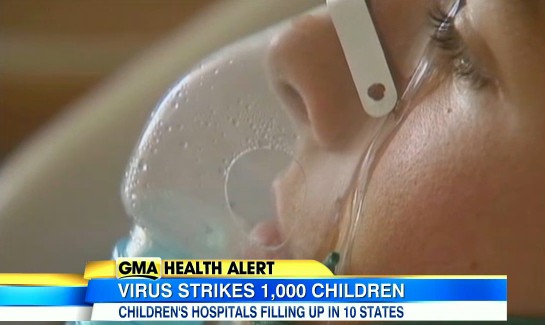DOCTORS: MYSTERIOUS CHILD VIRUS LIKELY TO SPREAD NATIONWIDE
 A respiratory illness that has already sickened more than a thousand children in 10 states is likely to become a nationwide problem, doctors say.
A respiratory illness that has already sickened more than a thousand children in 10 states is likely to become a nationwide problem, doctors say.
The disease hasn’t been officially identified but officials suspect a rare respiratory virus called human enterovirus 68. According to the U.S. Centers for Disease Control and Prevention, the virus is related to the rhinovirus, which causes the common cold.
The disease hasn’t been officially identified in every state, but in some states a rare respiratory virus called human enterovirus 68 has been found. According to the U.S. Centers for Disease Control and Prevention, the virus is related to the rhinovirus, which causes the common cold.
According to Mark Pallansch, director of the Division of Viral Diseases at the CDC, similar cases to the ones in Colorado have been cropping up across the U.S. At least 10 states — Missouri, Kansas, Illinois, Kentucky, Iowa, Colorado, Ohio, Oklahoma, North Carolina, and Georgia — have reported suspected outbreaks of human enterovirus 68 and requested CDC support.
“Viruses don’t tend to respect borders,” ABC News Chief Health and Medical Editor Dr. Richard Besser said. “It is only 10 states now, but it’s going to be across the country. So if your state doesn’t have it now, watch for it, it’s coming.”
Doctors say they are not even sure yet how this particular virus spreads, though the back-to-school season is a normal time for illnesses to spread among children.
“This is a very common time for outbreaks. Kids come back to school, they like to share things, they bring them home to their little brothers and sisters, and enteroviruses tend to occur in the summer,” Besser said. “But this one, this particular Enterovirus 68, is very rare and they have no idea why it showed up this year.”
At Children’s Hospital Colorado in Denver, officials say that between Aug. 18 and Sept. 4, doctors saw more than 900 pediatric patients with symptoms of the respiratory virus in the emergency room. Of those who came in, 86 were admitted into the hospital and a handful ended up in the intensive care unit.
“It can start just like a cold — runny nose, sneezing, coughs — but it’s the wheezing you have to watch out for,” Besser said.
Dr. Christine Nyquist, a pediatrician at Children’s Hospital Colorado, said the virus usually ends up appearing similar to a severe cold but can be particularly dangerous for children with asthma because of how it affects the respiratory system.
“The kids are coming in with respiratory symptoms, their asthma is exacerbated,” Nyquist said. “Kids with no wheezing are having wheezing.”
At Rocky Mountain Hospital for Children, Dr. Raju Meyappan, a pediatric critical care physician, said he’s seen at multiple children end up in the pediatric intensive care unit after being infected with the virus and that children under the age of 5 or those with asthma appear to be most at risk.
In one particularly severe case, Meyappan said a 13-year-old asthmatic patient ended up in the emergency room just one day after showing basic cold-like symptoms, including cough and runny nose.
His asthma became so severe on the second day the teenager turned blue and was rushed to the emergency room, where doctors gave him an emergency breathing tube.
The patient was one of multiple asthmatic pediatric patients who ended up sedated in the intensive care unit with a breathing tube, Meyappan said. Patients who needed breathing tubes spent between four to seven days sedated and intubated as they recovered, he said.


